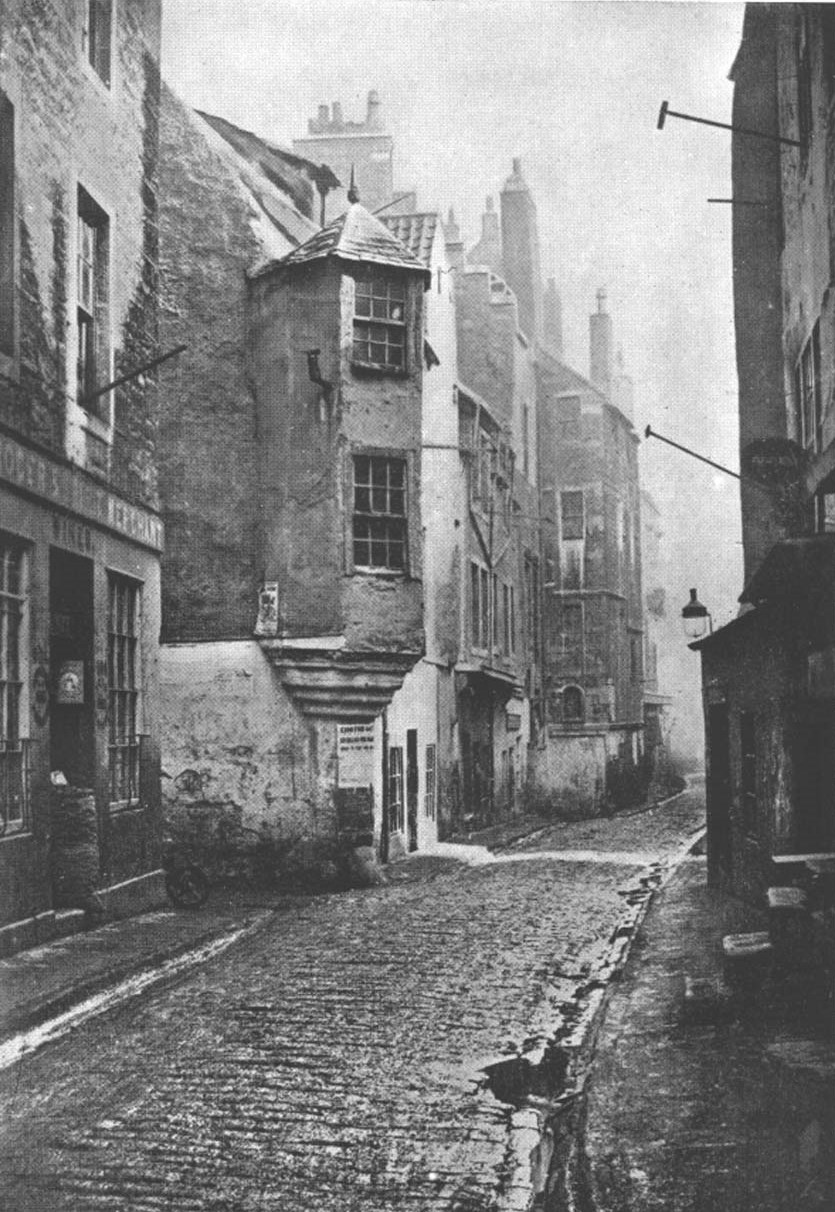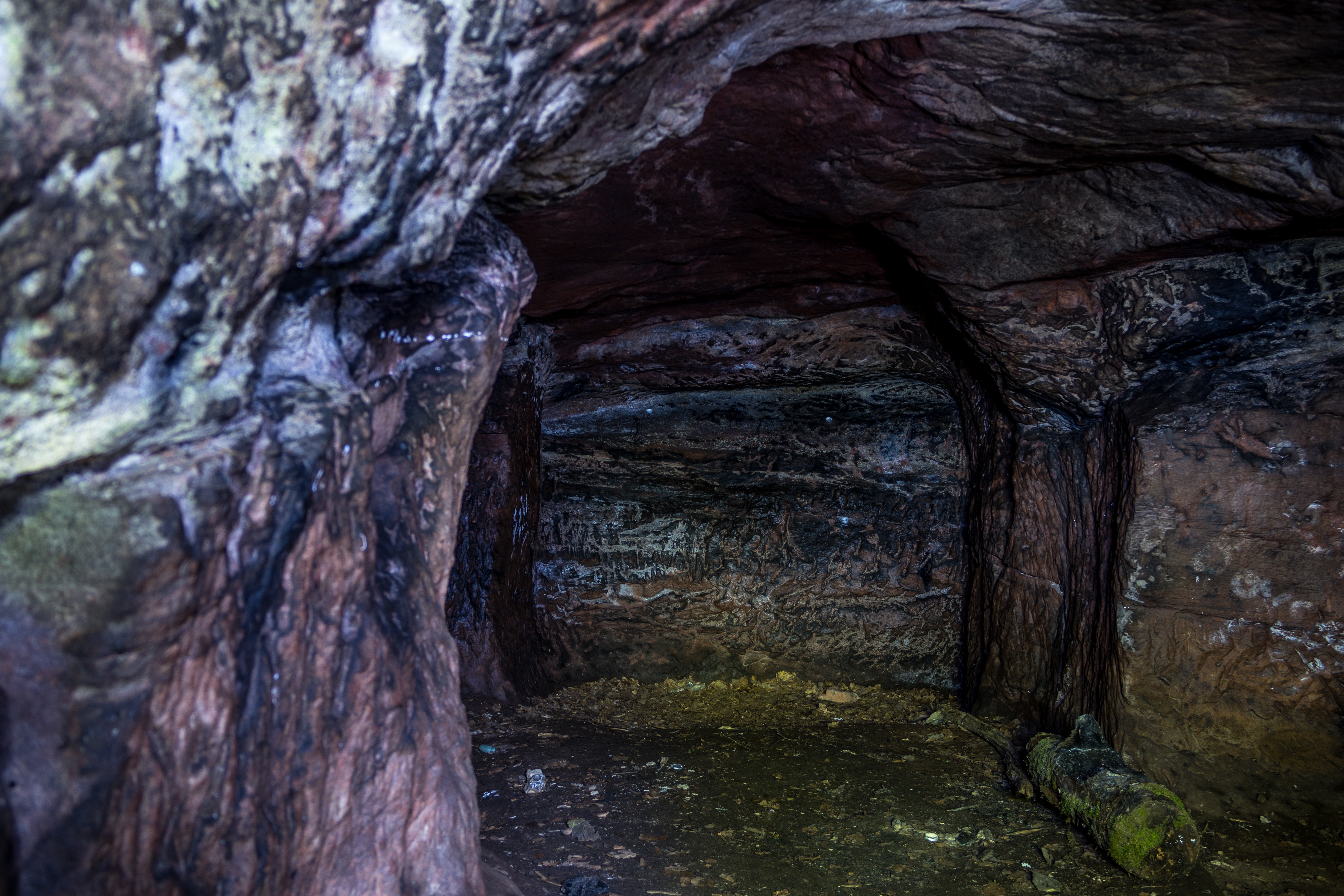|
Hawthornden Castle
Hawthornden Castle is located on the River North Esk in Midlothian, Scotland. The castle lies a mile to the east of Roslin at grid reference , and is just downstream from Roslin Castle. Hawthornden comprises a 15th-century ruin, with a 17th-century L-plan house attached. The house has been restored and now serves as a writer's retreat. Man-made caves in the rock beneath the castle have been in use for much longer than the castle itself. History Hawthornden was a property of the Abernethy family from the 13th century, and passed to the Douglases in the 14th century. The earliest parts of the castle date from the 15th century, and include a large three-storey tower, and the south curtain wall of a triangular courtyard. The castle was sacked twice by the Earl of Hertford in 1544 and 1547 during The Rough Wooing. In 1540 John Douglas sold trees from Hawthornden wood to James V as timber for his ships. The castle was later sold to Sir John Drummond, one of King James VI's usher ... [...More Info...] [...Related Items...] OR: [Wikipedia] [Google] [Baidu] |
Midlothian
Midlothian (; ) is registration county, lieutenancy areas of Scotland, lieutenancy area and one of 32 council areas of Scotland used for local government. Midlothian lies in the east-central Lowlands, bordering the City of Edinburgh council area, East Lothian and the Scottish Borders. The modern council area was formed in 1975 when the Midlothian (historic), historic county of Midlothian, also known as Edinburghshire, was altered substantially as part of local government reforms; its southern part formed a new Midlothian Districts of Scotland, District within the Local government areas of Scotland 1973 to 1996, Region of Lothian, whilst areas on the peripheries were assigned to other districts and the city of Edinburgh, which had always been autonomous to an extent, was formally separated as the Edinburgh (district), City of Edinburgh District. In 1996 Midlothian became a unitary authority area, using the same name and territory as in 1975. History Midlothian County Council w ... [...More Info...] [...Related Items...] OR: [Wikipedia] [Google] [Baidu] |
William Abernethy Drummond
William Abernethy Drummond (called Abernethy; 1719?–1809), was a physician who later became Bishop of Edinburgh. Life Born William Abernethy in 1719 or 1720, he was descended from the family of Abernethy of Saltoun in East Lothian and from William Drummond of Hawthornden. He first studied medicine, and took the degree of M.D., but was subsequently for many years minister of an Episcopalian church in Edinburgh. In Edinburgh he lived in the former house of Cardinal Beaton on the Cowgate. Having paid his respects to Prince Charles Edward, when he held his court at Holyrood in 1745, he was afterwards exposed to much annoyance and even danger on that account, and was glad to avail himself of his medical degree, and wear for some years the usual professional costume of the Edinburgh physicians. He took the additional surname of Drummond on his marriage, 3 November 1760, to Mary Barbara Drummond, widow of Robert Macgregor of Glengarnock, and daughter and heiress of William Drum ... [...More Info...] [...Related Items...] OR: [Wikipedia] [Google] [Baidu] |
Colin McWilliam
Colin McWilliam (1928–1989) was a British architecture academic and author. Career Born in London, he graduated from the University of Cambridge and became Director of the Scottish National Buildings Record, then the Assistant Secretary of the National Trust for Scotland. He also directed architectural history and conservation at Edinburgh College of Art, and later Heriot-Watt University. He was a founder of the Dictionary of Scottish Architects Project, and was instrumental in setting up the Architectural Heritage Society of Scotland. Studying at the British School in Rome he returned to Scotland in 1951 to work with architect Stewart Kaye and with the National Building Record. From 1965 to 1972 McWilliam was a Council member of the influential Edinburgh conservationist group the Cockburn Association. In the 1970s, he was approached by Sir Nikolaus Pevsner who, having completed the series ''The Buildings of England'', was keen to extend the project to cover the rest of ... [...More Info...] [...Related Items...] OR: [Wikipedia] [Google] [Baidu] |
William Wallace
Sir William Wallace (, ; Norman French: ; 23 August 1305) was a Scottish knight who became one of the main leaders during the First War of Scottish Independence. Along with Andrew Moray, Wallace defeated an English army at the Battle of Stirling Bridge in September 1297. He was appointed Guardian of Scotland and served until his defeat at the Battle of Falkirk in July 1298. In August 1305, Wallace was captured in Robroyston, near Glasgow, and handed over to King Edward I of England, who had him hanged, drawn and quartered for high treason and crimes against English civilians. Since his death, Wallace has obtained a legendary status beyond his homeland. He is the protagonist of Blind Harry's 15th-century epic poem '' The Wallace'' and the subject of literary works by Jane Porter and Sir Walter Scott, and of the Academy Award-winning film ''Braveheart''. Background William Wallace was a member of the lesser nobility, but little is definitely known of his family history ... [...More Info...] [...Related Items...] OR: [Wikipedia] [Google] [Baidu] |
Wallace's Cave
Wallace's Cave is situated in Roslin, Scotland, Roslin Glen, in Midlothian, Midlothian, Scotland beside the River North Esk. It is also known as Hawthornden Castle Cave, after the nearby castle. It takes its name from William Wallace who participated in the Battle of Roslin, which took place nearby on 24 February 1303. The cave was formed under water from limestone between 363 and 325 million years ago. Other Wallace's Cave sites * Wallace's Cave, Auchinleck, Wallace's Cave in Auchinleck, Auchinleck, East Ayrshire * A rock shelter near Lugar, East Ayrshire in the Cubs' Glen on the Glenmuir Water. * On the opposite side of the River Ayr from Wallace's Heel Well; it is said that Wallace used it to hide from English troops. No sign of it remains. * Bothwell Parish on the South Calder Water, South Calder Water, Lanarkshire, to the west of Cleland, North Lanarkshire, Cleland and close to the site of the old Ravenscraig steelworks. * A natural cave in the Cartland Craigs, Cartland C ... [...More Info...] [...Related Items...] OR: [Wikipedia] [Google] [Baidu] |
Alexander Ramsay Of Dalhousie
Sir Alexander Ramsay of Dalhousie (c. 1290–1342) (sometimes spelt: ''Dalwolsey'') was a Scottish nobleman and knight who fought for David II, King of Scots in the south of Scotland in the Second War of Scottish Independence. He is remembered especially for his actions during the siege of Roxburgh Castle. Life Alexander was the eldest of two sons born to Sir William Ramsay of Dalhousie (c. 1235–1320). Alexander's sibling was Sir William Ramsay of Inverleith. Military career Alexander fought with Sir Andrew Murray, Guardian of the Realm, at the Battle of Culblean in the Scottish victory over the English force on 30 November 1335 and later at Boroughmuir, where Guy de Namur, a Flemish ally of England, was defeated and captured. He was present at the capture of Leuchars Castle, at St Andrews in 1335. In June 1338 he smuggled supplies to Agnes Randolph, Countess of Dunbar allowing her to defend the castle against the siege by William Montagu, 1st Earl of Salisbury of En ... [...More Info...] [...Related Items...] OR: [Wikipedia] [Google] [Baidu] |
Robert The Bruce
Robert I (11 July 1274 – 7 June 1329), popularly known as Robert the Bruce (), was King of Scots from 1306 until his death in 1329. Robert led Kingdom of Scotland, Scotland during the First War of Scottish Independence against Kingdom of England, England. He fought successfully during his reign to restore Scotland to an independent kingdom and is regarded in Scotland as a folk hero, national hero. Robert was a fourth-great-grandson of King David I, and his grandfather, Robert de Brus, 5th Lord of Annandale, was one of the claimants to the Scottish throne during the "Great Cause". As Earl of Carrick, Robert the Bruce supported his family's claim to the Scottish throne and took part in William Wallace's campaign against Edward I of England. Appointed in 1298 as a Guardian of Scotland alongside his chief rival for the throne, John Comyn of Badenoch, and William Lamberton, Bishop of St Andrews, Robert resigned in 1300 because of his quarrels with Comyn and the apparently imminen ... [...More Info...] [...Related Items...] OR: [Wikipedia] [Google] [Baidu] |
Dovecote
A dovecote or dovecot , doocot (Scots Language, Scots) or columbarium is a structure intended to house Domestic pigeon, pigeons or doves. Dovecotes may be free-standing structures in a variety of shapes, or built into the end of a house or barn. They generally contain pigeonholes for the birds to nest. Pigeons and doves were an important food source historically in the Middle East and Europe and were kept for their eggs and dung. History and geography The oldest dovecotes are thought to have been the fortress-like dovecotes of Upper Egypt and the domed dovecotes of Iran. In these regions the droppings were used by farmers for fertilization. Pigeon droppings were also used for leather tanning and making gunpowder. In some cultures, particularly Medieval Europe, the possession of a dovecote was a symbol of status and power and was consequently regulated by law. Only nobles had this special privilege, known as ''droit de colombier''. Many ancient Manorialism, manors in Franc ... [...More Info...] [...Related Items...] OR: [Wikipedia] [Google] [Baidu] |
Harl
Harling is a roughcast, rough-cast wall finish consisting of lime and aggregate, known for its rough texture. Many castles and other buildings in Scotland and Ulster have walls finished with harling. It is also used on contemporary buildings, where it protects against the wet Climate of Scotland, Scottish and Northern_Ireland#Geography_and_climate, Ulster climates and eliminates the need for paint. Technique Harling as a process covers stonework using a plastering process involving a slurry of small pebbles or fine chips of stone. After a wall is complete and has been pointed and allowed to Curing (chemistry) , cure then a base of lime render is applied to the bare stone. While this render is still wet a specially shaped trowel is used to throw the pebbles onto the lime surface, which are then lightly pressed into it. Harl, being mostly lime render, cures chemically rather than simply drying. After this setting process, the harl is sometimes Whitewash, lime washed in a colour ... [...More Info...] [...Related Items...] OR: [Wikipedia] [Google] [Baidu] |
Carte De Visite Of Hawthornden Castle - George Washington Wilson - ABDMS022523
Carte may refer to: People * Alexander Carte (1805–1881), Irish British zoologist * Anto Carte (1886–1954), Belgian painter * Helen Carte (1852–1913), Scottish British businesswoman * Richard Carte (1808–1891), British flute-maker * Samuel Carte (1652–1740), English antiquarian * Thomas Carte (1686–1754), English historian * Omer Carte Qalib (1930–2020), Somalian politician * Carte Goodwin (born 1974), U.S. politician * Carte Said (born 1997), Italian soccer player Other uses * CARTE Museum (Cartographic Acquisition Research Teaching and Exhibition), Baton Rouge, Louisiana, USA * Carte network, a French resistance network See also * Deidre LaCarte, Canadian dancer * Julio Lacarte Muró (1918–2016), Uruguayan diplomat * * Card (other) * Cart (other) * Cartes (other) * Cartesian (other) * Descartes (other), including ''des Cartes'' * D'Oyly Carte (other) * Carte blanche (other) A blank cheque o ... [...More Info...] [...Related Items...] OR: [Wikipedia] [Google] [Baidu] |
Listed Building
In the United Kingdom, a listed building is a structure of particular architectural or historic interest deserving of special protection. Such buildings are placed on one of the four statutory lists maintained by Historic England in England, Historic Environment Scotland in Scotland, in Wales, and the Historic Environment Division of the Department for Communities in Northern Ireland. The classification schemes differ between England and Wales, Scotland, and Northern Ireland (see sections below). The term has also been used in the Republic of Ireland, where buildings are protected under the Planning and Development Act 2000, although the statutory term in Ireland is "Record of Protected Structures, protected structure". A listed building may not be demolished, extended, or altered without permission from the local planning authority, which typically consults the relevant central government agency. In England and Wales, a national amenity society must be notified of any work to ... [...More Info...] [...Related Items...] OR: [Wikipedia] [Google] [Baidu] |
Edinburgh
Edinburgh is the capital city of Scotland and one of its 32 Council areas of Scotland, council areas. The city is located in southeast Scotland and is bounded to the north by the Firth of Forth and to the south by the Pentland Hills. Edinburgh had a population of in , making it the List of towns and cities in Scotland by population, second-most populous city in Scotland and the List of cities in the United Kingdom, seventh-most populous in the United Kingdom. The Functional urban area, wider metropolitan area had a population of 912,490 in the same year. Recognised as the capital of Scotland since at least the 15th century, Edinburgh is the seat of the Scottish Government, the Scottish Parliament, the Courts of Scotland, highest courts in Scotland, and the Palace of Holyroodhouse, the official residence of the Monarchy of the United Kingdom, British monarch in Scotland. It is also the annual venue of the General Assembly of the Church of Scotland. The city has long been a cent ... [...More Info...] [...Related Items...] OR: [Wikipedia] [Google] [Baidu] |









